Lupine Flowers: Grow & Care for Lupinus
Written by Iris
Sep 16 2021
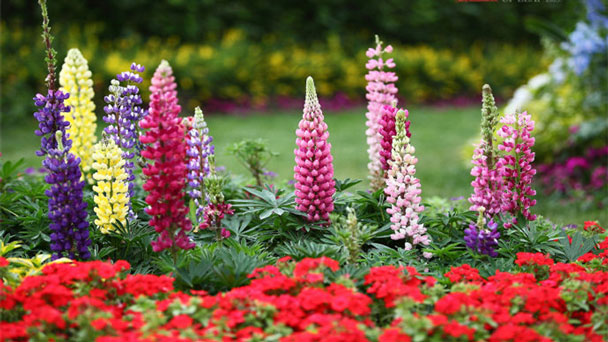
Lupine (Lupinus) grows naturally in the wild, adding a vibrant touch of color each spring. Lupine (Lupinus) are mainly perennial herbs, but in certain climates where winters are too cold, it is best to treat them as annuals. You can also grow Lupine (Lupinus) indoors. Native to North America, Lupine (Lupinus) thrive in almost any soil and can handle plenty of sun or partial shade with no problems. Following are details on how to grow and care for Lupine (Lupinus).
This plant likes a bit of space to thrive and lends itself well to being grown in a garden border more than a narrow flower bed.
We don't recommend planting lupins in containers where possible, because this leads to less strong growth and can leave them more susceptible to aphids (more on these fellas later).
Before sowing, seeds can be soaked for 24 hours in a small amount of water. Though this isn’t necessary, it can help them to start growing more quickly.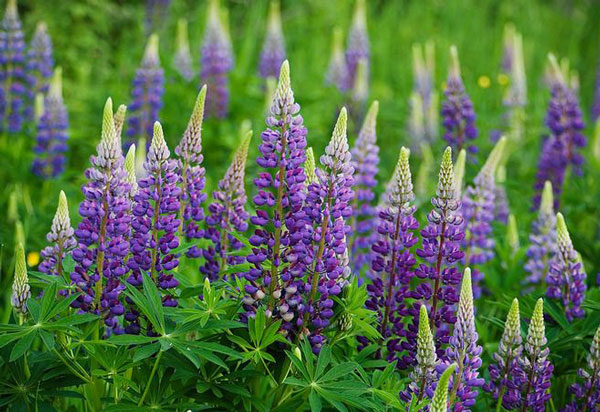
Soak the lupin seeds for 24 hours in cold water or nick the outer seed coat with a knife to promote even germination.
Plant out when quite small, as lupin seeds develop a taproot and resent disturbance to their roots.
Moisten the sand and allow the containers to drain so that there is no standing water. The sand should be construction or masonry sand, not play sand. Playing is very fine and holds water.
Cut the stem of a mature lupine with a sharp knife or razor blade. The nail should have a “heel” or a small section of the original nail attached to the basal end of the cut. A well-harvested cut will look as if a flap of the parent plant’s bark is still attached to the end of the cut stem.
Remove all leaves from the stems of the lupine, except the upper part, holding the upper part of the stem with one hand and sliding the rest of the stem between your index finger and thumb. Make a horizontal cut in half of the remaining leaves so that the leaves are half the original size. Glue the cuttings to the coarse sand and firm the sand around the stem.
Insert wooden skewers or bamboo poles into the sand along the outer edge of each cultivation container. Keep the tips of the piles about 2 to 3 inches above the lupine piles.
Cover the cultivation container with a clear plastic film so that the cuttings are covered, but the plastic rests on the cuttings. Hold the plastic in place with an elastic band around the top edge of the container.
Grow the lupine until the size is such that it is not lost in the landscape. Remove the bottom of the peat pot and plant the potted lupine in the garden in a sunny location. This prevents the roots from being disturbed because lupines don't like to be transplanted.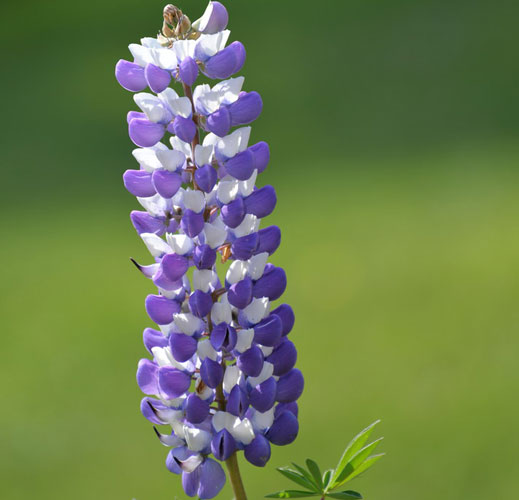
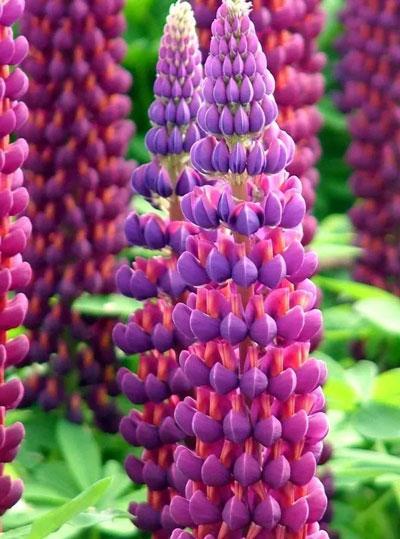
Poor flowering may be caused by too much shade or by dividing clumps too often. With plants in containers, it may also be caused by overpotting or being excessively pot-bound. Repot every three years or so, into a container that is only slightly larger. To improve flowering, water and feed in spring
Several pests have a taste for lupins, principally slugs and snails, which love the new shoots in spring, but also look out for lupin aphids
Fungal diseases such as lupin anthracnose and powdery mildew can affect lupins, along with viruses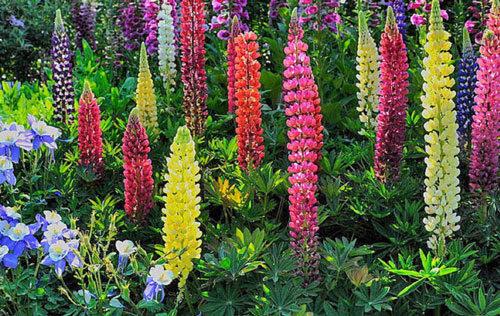
Russell mixed colors: Bred in 1937 and naturalized in many areas, this hybrid rainbow and bicolor mixture is the foundation for all new cultivars.
Gallery series: Dense flower spikes on this compact plant grow no more than 2 feet tall.
'Dwarf Lulu': These plants grow about 2 feet tall in a rainbow of hues and feature unusually dense racemes.
'Minarette': This 18-inch variety looks stunning in drifts along a border's edge or in containers.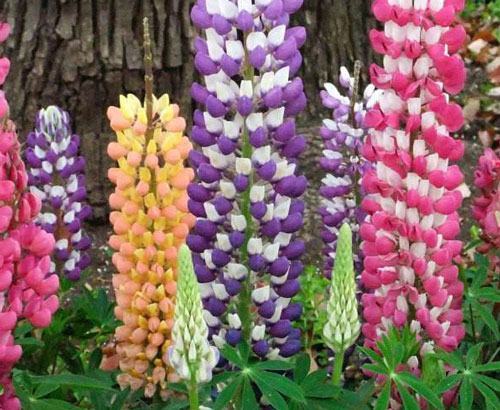
Besides, not only pets are known for intoxicating themselves with this plant, as it is also relatively common for livestock to intoxicate themselves with the wild version of this flower.
General symptoms in those intoxicated include convulsions, slowed pulse, sleepiness, lack of awareness, and even respiratory issues.
They usually form in the leaf armpit, the junction between the leaf and the stem. Prevent the spread of plant diseases by disinfecting the knife or blades and rubbing them with isopropyl alcohol after each cut.
After you deadhead a lupine, give it a good amount of moisture to help the plant have a second display of strong flowers, which usually occurs several weeks later. Make sure that the plant receives at least 1 inch of water per week.
This is especially important during periods of drought, which can stress the lupine and interfere with the formation of new flower buds. To avoid the growth of fungi, watering the lupins in the root area
Where to Grow Lupine (Lupinus)When to Grow Lupine (Lupinus)How to Grow Lupine (Lupinus)Lupine Propagation with SeedsLupine Propagation with CuttingsLupine Propagation with DivisionHow to Care for Lupine (Lupinus)Light CareSoil CareWater CareTemperature and Humidity CareFertilizer CarePruning CarePests and Diseases CareVarieties of Lupine (Lupinus)Lupine (Lupinus) FAQWhere does the lupine come from?How long do lupines bloom?Which lupines are edible?Are lupine flowers toxic?How to Deadhead Lupins?
Where to Grow Lupine (Lupinus)
Lupins are sun worshipers, but they also enjoy cool soil. Positioning newly planted flowers where they will receive full sun in the morning and shade in the afternoon will give them the best of both worlds, and help them to survive the summer heat. Don’t plant in full shade: They won't thrive.This plant likes a bit of space to thrive and lends itself well to being grown in a garden border more than a narrow flower bed.
We don't recommend planting lupins in containers where possible, because this leads to less strong growth and can leave them more susceptible to aphids (more on these fellas later).
When to Grow Lupine (Lupinus)
Although there is some leeway with when to plant (we mentioned February to September for sowing earlier), Lupins stand to do best when sown in early March, hardened off in late April and planted out in early May. If you are harvesting seeds, this should be done in late summer, around early August.Before sowing, seeds can be soaked for 24 hours in a small amount of water. Though this isn’t necessary, it can help them to start growing more quickly.

How to Grow Lupine (Lupinus)
Lupine Propagation with Seeds
The seed of annual or perennial species should be sown during spring, summer or autumn in individual jiffy pots, seed modules or small pots.Soak the lupin seeds for 24 hours in cold water or nick the outer seed coat with a knife to promote even germination.
Plant out when quite small, as lupin seeds develop a taproot and resent disturbance to their roots.
Lupine Propagation with Cuttings
Lupinus is rarely propagated by cutting because the long axial root is usually damaged during the process. Lupine cuttings, harvested in early spring, produce an exact duplicate of the parent plant. Fill the cultivation containers with coarse sand.Moisten the sand and allow the containers to drain so that there is no standing water. The sand should be construction or masonry sand, not play sand. Playing is very fine and holds water.
Cut the stem of a mature lupine with a sharp knife or razor blade. The nail should have a “heel” or a small section of the original nail attached to the basal end of the cut. A well-harvested cut will look as if a flap of the parent plant’s bark is still attached to the end of the cut stem.
Remove all leaves from the stems of the lupine, except the upper part, holding the upper part of the stem with one hand and sliding the rest of the stem between your index finger and thumb. Make a horizontal cut in half of the remaining leaves so that the leaves are half the original size. Glue the cuttings to the coarse sand and firm the sand around the stem.
Insert wooden skewers or bamboo poles into the sand along the outer edge of each cultivation container. Keep the tips of the piles about 2 to 3 inches above the lupine piles.
Cover the cultivation container with a clear plastic film so that the cuttings are covered, but the plastic rests on the cuttings. Hold the plastic in place with an elastic band around the top edge of the container.
Grow the lupine until the size is such that it is not lost in the landscape. Remove the bottom of the peat pot and plant the potted lupine in the garden in a sunny location. This prevents the roots from being disturbed because lupines don't like to be transplanted.
Lupine Propagation with Division
For perennial varieties including the Russell hybrids, you can propagate by carefully dividing the crown in early spring before growth commences, to avoid the possibility of root rot. Alternatively, take a cutting from the base of the stem of new shoots in mid to late spring with a small slice of the yellow rootstock attached. Place in pure perlite to prevent rotting.
How to Care for Lupine (Lupinus)
Light Care
Lupines need full sun to thrive. Although, in some areas where the heat is too intense during summer, it is advisable to grow this flower in a partially shaded area.Soil Care
Lupins grow best in free draining soils with a pH around 6.5–7. They can survive in relatively poor soils due to their nitrogen-fixing roots. Adequate moisture in their growth phase from spring to early summer is essential for healthy growth. Winter wet conditions may cause root rot. On farms, lupins are often planted by seed, grown to maturity and then turned into the soil, before planting with other vegetable or grain crops, as their nitrogen-fixing roots improve nutrient-deficient soils. This is often called a ‘green manure’ crop.Water Care
The hardy lupines don’t need much water but they prefer moist soil nonetheless. So make sure to give them the equivalent of one inch of rain once a week. That’s enough to keep the soil moist. In the summer months, cover the topsoil with a thick layer of mulch to improve water retention. Mulch will also help you fight off weeds that compete with the plants and stunt their growth. The plant’s watering needs will become less as the temperature drops. So hold off watering in the winter. Make sure the top three inches of the soil are dry before you water it.Temperature and Humidity Care
Lupines like climates with fairly cool summers. They don't do well in hot, humid climates, such as that of the Southern United States. High heat and strong sunlight can result in the plants failing to flower. In hot climates, a light layer of mulch around the lupines can help to retain soil moisture and keep the roots cool.
Fertilizer Care
Lupine plant varieties benefit from 2 to 4 inches of manure or compost added to the soil at planting time. Otherwise, lupines, like most wildflower types, generally require no supplemental fertilizer and rich, over-fertilized soil often serves to produce a lush crop of weeds. If your soil is poor or plant growth appears stunted, use a light application of a general-purpose garden fertilizer with a ratio such as 10-10-10 once every month during spring and summer.Pruning Care
Remove fading flowers promptly before the hairy pods swell, to prevent the plant from going to seed and reducing its vigour. This will encourage a second flush of flowers later in summer, although these will be smaller than the first spikes. In autumn or after the first frost, cut the stems back down to the ground.Pests and Diseases Care
Even though lupins are easy to grow, they are occasionally subject to problems:Poor flowering may be caused by too much shade or by dividing clumps too often. With plants in containers, it may also be caused by overpotting or being excessively pot-bound. Repot every three years or so, into a container that is only slightly larger. To improve flowering, water and feed in spring
Several pests have a taste for lupins, principally slugs and snails, which love the new shoots in spring, but also look out for lupin aphids
Fungal diseases such as lupin anthracnose and powdery mildew can affect lupins, along with viruses

Varieties of Lupine (Lupinus)
Before growing lupine, there are several lupine varieties available that vary in appearance you should konw, including:Russell mixed colors: Bred in 1937 and naturalized in many areas, this hybrid rainbow and bicolor mixture is the foundation for all new cultivars.
Gallery series: Dense flower spikes on this compact plant grow no more than 2 feet tall.
'Dwarf Lulu': These plants grow about 2 feet tall in a rainbow of hues and feature unusually dense racemes.
'Minarette': This 18-inch variety looks stunning in drifts along a border's edge or in containers.

Lupine (Lupinus) FAQ
Where does the lupine come from?
Lupines are originally from North America, but were introduced in the early 19th century. Brought to Europe, where they have since been found as wild shrubs.How long do lupines bloom?
Lupines bloom from late May to early August, around four months.Which lupines are edible?
Since lupines contain toxic alkaloids, the seeds must be soaked in brine for about 14 days before they can be eaten. The situation is different with the seeds of low-alkaloid varieties - so-called sweet lupins. These only have to be soaked for a day or two before they can be processed further.Are lupine flowers toxic?
Most of the lupine genus are toxic to highly-sensitive humans and animals. If you are thinking of planting them, make sure no pets or children are allowed to digest the seed pods or any other part of the plant, as they are considered to have the highest toxicity levels.Besides, not only pets are known for intoxicating themselves with this plant, as it is also relatively common for livestock to intoxicate themselves with the wild version of this flower.
General symptoms in those intoxicated include convulsions, slowed pulse, sleepiness, lack of awareness, and even respiratory issues.
How to Deadhead Lupins?
Lupines are easily deadheaded when most of the flowers on a spike wither and before drying and giving seeds, deadhead by cutting the spike with a sharp knife or garden shears. Make the cut on the stem just behind the ear, at a point where you see small growth shoots.They usually form in the leaf armpit, the junction between the leaf and the stem. Prevent the spread of plant diseases by disinfecting the knife or blades and rubbing them with isopropyl alcohol after each cut.
After you deadhead a lupine, give it a good amount of moisture to help the plant have a second display of strong flowers, which usually occurs several weeks later. Make sure that the plant receives at least 1 inch of water per week.
This is especially important during periods of drought, which can stress the lupine and interfere with the formation of new flower buds. To avoid the growth of fungi, watering the lupins in the root area
Latest Updated
- Benefits of Bugleweed - 7 Science-backed Health Benefits
- Bugleweed Dangers & Side Effects - Is It Poisonous?
- How to Plant Evergreen Trees - What You Should Know
- When to Plant Evergreens - Grow Guide for Evergreen Trees
- 12 Wonderful Evergreen Shrubs for Your Garden
- 12 Popular Evergreen Plants with Pictures for Beginners
- When And How To Prune A Lilac Bush Like a Pro
- How to Grow & Care for Lilac Vine (Hardenbergia Violacea)
- Japanese Lilac Tree (Syringa Reticulata) Care & Propagation Guide
- Shumard Oak Pros and Cons - What to Know
Popular Articles
- Winter maintenance of Antirrhinum Majus
- How to Grow Terminalia Mantaly Tree
- How to Grow and Care for Crossostephium Chinense
- How to grow Antirrhinum Majus in spring
- Peristeria Elata (Dove Orchid) Profile: Info & Care Guide
- Underwatered Snake Plant (Sansevieria Trifasciata) - Signs And How To Fix
- How to Care for Brazilian Jasmine Plant (Mandevilla Sanderi)
- How to Grow & Care for Graptopetalum Purple Delight in Summer
- Rosa Chinensis (China Rose): Plant Growing & Care Tips
- How to Care for Baby Sun Rose (Aptenia Cordifolia)